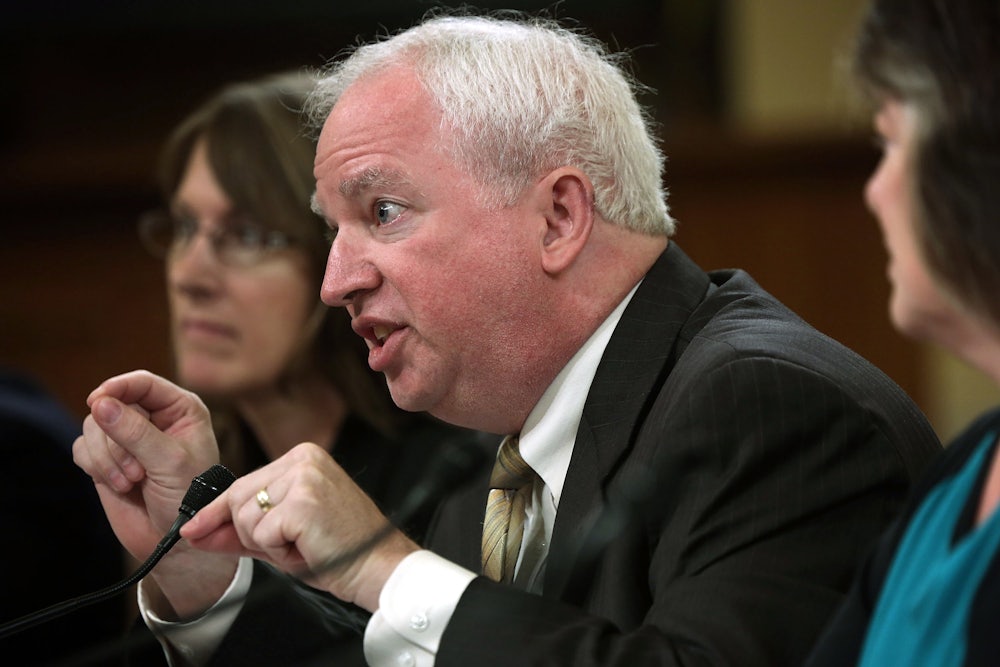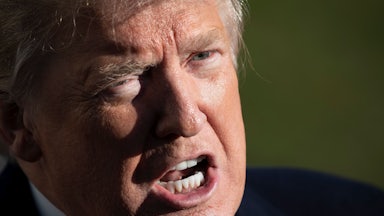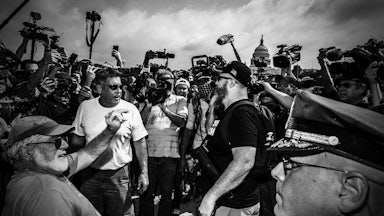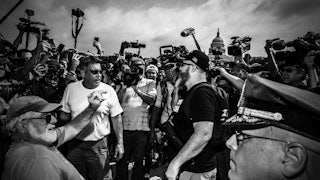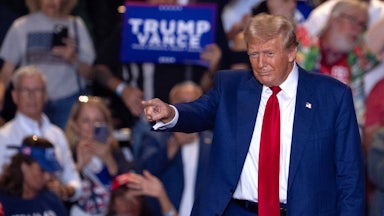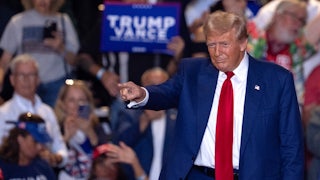How close did America come to constitutional collapse on January 6? Closer than we knew. Earlier this week, CNN obtained a disturbing memo written by one of Trump’s legal advisers during the two-month period between Election Day last year and January 6. Conservative lawyer John Eastman proposed that then–Vice President Mike Pence could try to overturn the election results during the joint session of Congress and give Trump a second term. In practical terms, it describes a plan for carrying out a coup d’état—one in which Pence would single-handedly throw out legitimate votes for Biden until Trump had enough to win.
According to a new book by Washington Post reporters Bob Woodward and Robert Costa, Trump used Eastman’s arguments to try to convince Pence to carry out the scheme. Pence did not reject it out of hand; he reportedly consulted fellow Hoosier and former Vice President Dan Quayle, who emphatically told Pence that he had no power to exclude electoral votes. Pence ultimately agreed and drew Trump’s fury at the perceived betrayal. From there came Trump’s incitement of a mob, the mob’s attack on the Capitol, and the end to a two-century tradition of peaceful transitions of American power.
Last weekend in Washington, D.C., supporters of those who attacked the Capitol that day staged a planned rally in front of the U.S. Capitol. It ended up being a more subdued spectacle, with seemingly more media in attendance than Trump loyalists and Proud Boys. One might take comfort from the fact that the same violent urgings failed to materialize. But what the Eastman saga shows is that future coup attempts aren’t likely to come from pitched battles with mobbed-up insurgents inside the halls of government. They’ll be conducted by memoranda between ideologues who understand that our democracy is not self-enforcing but rather built on the willingness of people in power to accept and defend it.
Who is John Eastman, and how did he almost destroy the republic? The 61-year-old lawyer’s résumé features some of the top credentials of the conservative legal movement: clerkships with former Judge Michael Luttig and Justice Clarence Thomas, the chairmanship of the Federalist Society’s Federalism and Separation of Powers Practice Group, and the directorship of a public-interest legal group to advance conservative goals under the aegis of the Claremont Institute. He also worked as a tenured constitutional law professor at Chapman University until retiring under intense pressure after he spoke to a pro-Trump rally in D.C. on January 6.
You might have seen his work before. In August 2020, Eastman published an op-ed in Newsweek arguing, in a just-asking-questions fashion, that Kamala Harris might be ineligible for the vice presidency because her parents were not U.S. citizens at her birth. A casual glance at Harris’s Wikipedia page tells us that she was born in Oakland, California, in 1964. A passing familiarity with American history reminds us that Oakland and the rest of California have been part of the United States since 1850. Harris is therefore a natural-born U.S. citizen through birthright citizenship, at least according to the overwhelming consensus of courts and legal scholars, as well as the plain language of the Fourteenth Amendment’s Citizenship Clause.
Maybe she isn’t, Eastman argued, because birthright citizenship itself may not be fully constitutional. The Citizenship Clause says that anyone born on U.S. soil who is “subject to the jurisdiction” of the United States is a U.S. citizen. The clause’s qualifier was meant to exclude children of foreign diplomats, an interpretation confirmed by the Supreme Court in Wong Kim Ark v. United States in 1898. Eastman tried to make a hair-splitting effort to distinguish Harris’s situation from that case by questioning whether her parents were lawful permanent residents when she was born. But since green cards didn’t exist until World War II, they clearly weren’t necessary for Wong Kim Ark’s parents in the nineteenth century and wouldn’t be necessary for Kamala Harris’s parents in 1964.
This trend of motivated reasoning suffuses Eastman’s January 6 memo. He hangs his argument on a perceived disparity between the Twelfth Amendment, which altered the original procedures for electing the president and vice president, and the Electoral Count Act of 1887, which builds upon the Twelfth Amendment to provide more clarity on the process. The Electoral Count Act is not without its flaws, and there are strong calls for Congress to reform and clarify it, of course. But Eastman is not making a good-faith effort to clarify presidential election laws; he is laying out a case to use them to stage an effective coup.
The question is both simple and complex: What happens if Congress receives multiple slates of electors from a single state or the results are otherwise disputed on January 6? The Twelfth Amendment is silent on that question. It simply says that “the President of the Senate shall, in the presence of the Senate and House of Representatives, open all the certificates and the votes shall then be counted.” (By default, the president of the Senate is the vice president of the United States.) This ambiguity led to a constitutional crisis in 1877 and prompted Congress to pass a law to handle future disputes. The Electoral Count Act generally gives Congress itself the discretion to resolve presidential electoral disputes.
Eastman argued that the Electoral Count Act is “likely unconstitutional,” for reasons he does not fully explain, and should be disregarded. In his view, the Twelfth Amendment gives the vice president the discretion to decide which states’ electoral votes should be counted if there is a dispute, and Congress just sits there and watches him do it. Pence, Eastman argued, should throw out the electors from the seven states where Trump and his allies allege, baselessly, that voter fraud led to a Biden win. One of two things would then happen, either of which would result in Trump’s reelection.
At the end, [Pence] announces that because of the ongoing disputes in the 7 States, there are no electors that can be deemed validly appointed in those States. That means the total number of “electors appointed”—the language of the 12th Amendment—is 454. This reading of the 12th Amendment has also been advanced by Harvard Law Professor Laurence Tribe (here). A “majority of the electors appointed” would therefore be 228. There are at this point 232 votes for Trump, 222 votes for Biden. Pence then gavels President Trump as re-elected.
Howls, of course, from the Democrats, who now claim, contrary to Tribe’s prior position, that 270 is required. So Pence says, fine. Pursuant to the 12th Amendment, no candidate has achieved the necessary majority. That sends the matter to the House, where the “the votes shall be taken by states, the representation from each state having one vote.…” Republicans currently control 26 of the state delegations, the bare majority needed to win that vote. President Trump is re-elected there as well.
It’s worth underscoring the full nature of what Eastman proposed here. The 2020 election was free, fair, and legitimate, and there was zero evidence of serious or significant fraud. Americans simply voted to elect Joe Biden as their next president in overwhelming numbers. Trump disputed those results by lying about widespread voter fraud before and after Election Day. Eastman then argued that Trump and Pence could use those false claims to ignore the voters and the Electoral Count Act and grant themselves another four years in power. It was a staggeringly corrupt plan that would have collapsed American democracy and almost certainly led to widespread civil unrest, if not bloodshed—all because Trump could not handle the embarrassment of losing a presidential election.
Eastman’s gambit ultimately relies upon the Supreme Court, through either action or inaction, to give its blessing to the entire scheme—but only after it becomes a fait accompli. “The main thing here is that Pence should do this without asking for permission—either from a vote of the joint session or from the [Supreme] Court,” Eastman wrote. “Let the other side challenge his actions in court, where Tribe (who in 2001 conceded the President of the Senate might be in charge of counting the votes) and others who would press a lawsuit would have their past position—that these are non-justiciable political questions—thrown back at them, to get the lawsuit dismissed.”
This part would almost be funny if it weren’t so serious. Eastman appears to be under the impression that courts interpret Laurence Tribe’s writings instead of the Constitution or acts of Congress. It is no slight against Tribe to say that this is simply not true. What a Harvard law professor writes, no matter how prominent he may be, is not binding precedent for any court in America. The Democratic Party is also not obligated to accept, let along adopt, Tribe’s reasoning in any instance, so Eastman’s insinuations about their “howls” being hypocritical are pure nonsense. As much as Eastman may wish otherwise, there is no Owning the Libs Clause in the Constitution.
Americans often describe things as “constitutional” or “unconstitutional.” The Constitution itself is vague enough to justify those debates. But “unconstitutional” is not right to describe the contents of this memo. What Eastman proposed—and what Trump sought and what Pence considered—is better described as anti-constitutional, a thorough rejection of its letter, spirit, and purpose. The Constitution exists above all else to provide for American self-government. It is inconceivable that the Founders intended for vice presidents to be able to overturn presidential elections on false grounds for their own potential gain, and the text they drafted cannot be plausibly read to allow it.
Ned Foley, an Ohio State University law professor who specializes in election law, is skeptical of Eastman’s strategy as applied to the 2020 election on practical grounds. “Had Pence done any of what Eastman’s memo suggested, the plot would not have prevailed because the House of Representatives under Speaker Pelosi’s leadership would have caused the Twelfth Amendment’s joint session to come to a halt incomplete,” he wrote earlier this week. Foley noted that Democrats controlled the House at the time and they could have simply ended the joint session when the scheme became apparent. Pelosi could have waited until Pence’s term as vice president expired on January 20 and then restarted the joint session, this time with Vermont Senator Patrick Leahy acting as president pro tempore in lieu of the vacant vice presidency. She would also briefly serve as acting president after Trump left office.
That analysis is slightly reassuring in the context of January 6, 2021. It’s also deeply alarming for January 6, 2025. Whatever schemes the Republicans could hatch, short of violence, the ultimate backstop was that Democrats controlled the House of Representatives that day. Throwing out a disputed slate of electors requires the assent of both houses, and the House Democratic majority’s existence ensured it would not succeed. If Republicans control one or both houses of Congress the next time this rolls around, and if Trump or his successor convinces GOP lawmakers to abuse the electoral counting process for their own gain, the nation could face an even greater crisis than the one that unfolded nine months ago.
There is no law strong enough to prevent future John Eastmans and Donald Trumps from plotting similar anti-constitutional schemes in 2025 or beyond. But there are steps that can be taken to make it harder for them to succeed. The best solution here is to strengthen and clarify the Electoral Count Act of 1887, as I wrote in June and as other commentators and legal scholars have also urged. Congress can and should take steps like making it harder for lawmakers to launch spurious challenges of electors and clarifying the vice president’s lack of discretion over the ballots before the next presidential election. The stakes for American democracy if they fail could not be higher.
